A Technique to Determine the Breakthrough Pressure of Shale Gas Reservoir by Low-Field Nuclear Magnetic Resonance
Abstract
:1. Introduction
2. Principle of Shale NMR Measurement
3. Methodology and Model Establishment
3.1. Preparation of Shale Core Samples
3.2. Low-Field NMR Measurement
3.3. Establishment of Calculation Model
4. Breakthrough Pressure Calculation Model
4.1. Physical Property Characterization of Shale Reservoir
4.2. Shale NMR T2 Spectrum
4.3. Relationship between Gas Breakthrough Pressure and Relevant Parameters
4.4. Validation of the Gas Breakthrough Pressure Calculation Model
5. Application
6. Conclusions
- (1)
- The gas breakthrough pressure of shale is power-exponentially related to the geometric mean of NMR T2 spectrum. As the geometric mean increases, the gas breakthrough becomes less difficult.
- (2)
- The gas breakthrough pressure of shale is related to the shale pore diameter and pore size, inversely related to the pore diameter and positively related to the proportion of micropores. The higher the proportion of micropores, the more difficult the gas breakthrough.
- (3)
- There is a linear relationship between the measured gas breakthrough pressure of saturated rock sample using the HTHP breakthrough pressure tester and the predicted gas breakthrough pressure calculated by the low-field NMR gas breakthrough pressure model. On this basis, the gas breakthrough pressure can be corrected, allowing an objective evaluation of the sealing capacity of caprocks.
- (4)
- The proposed theoretical model has been successfully applied. The technique of NMR logging evaluation on sealing capacity of shale is worthy of promotion. It extends the application of NMR logging to efficiently solve practical challenges.
- (5)
- The fitting coefficients of a, b and c will vary from different regions and different layers and there is no uniform coefficient. Therefore, the future research direction is to unify the fitting coefficients.
Author Contributions
Funding
Institutional Review Board Statement
Informed Consent Statement
Data Availability Statement
Conflicts of Interest
Nomenclature
| NMR | Nuclear Magnetic Resonance |
| T2 | longitudinal relaxation time |
| CT | computed tomography |
| T1 | transverse relaxation time |
| MHz | Mega Hertz |
| the proportion of micropores | |
| the area of micropores in the NMR T2 spectrum | |
| the total area of the NMR T2 spectrum | |
| the geometric mean of NMR T2 spectrum | |
| the gas breakthrough pressure | |
| Ro | reflectance of vitrinite |
| HTHP | high temperature and high pressure |
| TOC | total organic carbon |
References
- Li, J.R.; Yang, Z.; Wu, S.T.; Pan, S.Q. Key issues and development direction of petroleum geology research on source rock strata in China. Adv. Geo-Energy Res. 2021, 5, 121–126. [Google Scholar] [CrossRef]
- Hu, W.X.; Lu, X.C.; Fan, M.; Zhang, D.W.; Cao, J. Advances in the research of shale caprocks: Type, micropore characteristics and sealing mechanisms. Bull. Mineral. Petrol. Geochem. 2019, 38, 885–897. [Google Scholar] [CrossRef]
- Hinai, A.A.; Rezaee, R.; Esteban, L.; Labani, M. Comparisons of pore size distribution: A case from the Western Australian gas shale formations. J. Unconv. Oil Gas Resour. 2014, 8, 1–13. [Google Scholar] [CrossRef]
- Krooss, B.M.; Leythaeuser, D. Diffusion of methane and ethane through the reservoir caprock: Implications for the timing and duration of catagenesis: Discussion. AAPG Bull. 1997, 81, 155–161. [Google Scholar] [CrossRef]
- Boulin, P.F.; Brretonnier, P.; Vassil, V.; Samouillet, A.; Fleury, M.; Lombard, J.M. Sealing efficiency of caprocks: Experimental investigation of entry pressure measurement methods. Mar. Pet. Geol. 2013, 48, 20–30. [Google Scholar] [CrossRef]
- Arif, M.; Barifcani, A.; Lebedev, M.; Iglauer, S. Structural trapping capacity of oil-wet caprock as a function of pressure, temperature and salinity. Int. J. Greenh. Gas Control. 2016, 50, 112–120. [Google Scholar] [CrossRef]
- Fu, G.; Hu, M.; Yu, D. Volcanic caprock type and evaluation of sealing gas ability: An example of Xujiaweizi depression. J. Jilin Univ. 2010, 40, 237–244. [Google Scholar] [CrossRef]
- Fan, M.; Chen, H.Y.; Yu, L.J.; Zhang, W.T.; Liu, W.X.; Bao, Y.J. Evaluation standard of mudstone caprock combining specific surface area and breakthrough pressure. Pet. Geol. Exp. 2011, 33, 87–90. [Google Scholar] [CrossRef]
- Li, S.J.; Zhou, Y.; Sun, D.S. Rock mechanic experiment study of evaluation on caprock effectiveness. Pet. Geol. Exp. 2013, 35, 574–578. [Google Scholar] [CrossRef]
- Kawaura, K.; Akaku, K.; Nakano, M.; Ito, D.; Takahashi, T.; Kiriakehata, S. Examination of methods to measure capillary threshold pressures of pelitic rock samples. Energy Procedia 2013, 37, 5411–5418. [Google Scholar] [CrossRef] [Green Version]
- Yao, Y.B.; Liu, D.M. Comparison of low-field NMR and mercury intrusion porosimetry in characterizing pore size distributions of coals. Fuel 2012, 95, 152–158. [Google Scholar] [CrossRef]
- Clarkson, C.R.; Solano, N.; Bustin, R.M.; Bustin, A.M.M.; Blach, T.P. Pore structure characterization of North American shale gas reservoirs using USANS/SANS, gas adsorption, and mercury intrusion. Fuel 2013, 103, 606–616. [Google Scholar] [CrossRef]
- Liu, Z.J.; Yang, D.; Shao, J.X.; Hu, Y.Q. Evolution of pore connectivity in the Fushun oil shale by low-field nuclear magnetic resonance spectroscopy. Chin. J. Magn. Reson. 2019, 36, 309–318. [Google Scholar] [CrossRef]
- Zhang, Z.; Yan, J.; Hua, S.; Chen, H.H.; Liu, H.Q.; Zhang, Z.H. A new method of field NMR analysis on physical properties of shale oil reservoirs. Annu. Meet. Chin. Geosci. Union 2020, 2020, 2678–2681. [Google Scholar] [CrossRef]
- Zhao, P.Q.; Sun, Z.C.; Luo, X.P.; Wang, Z.L.; Mao, Z.Q.; Wu, Y.Z.; Xia, P. Study on the response mechanisms of nuclear magnetic resonance (NMR) log in tight oil reservoirs. Chin. J. Geophys. 2016, 5, 1927–1937. [Google Scholar] [CrossRef]
- Li, G.Y.; Ma, Z.L.; Zheng, J.X.; Pao, F.; Zheng, L.J. NMR analysis of the physical change of oil shales during in situ pyrolysis at different temperatures. Pet. Geol. Exp. 2016, 38, 402–406. [Google Scholar] [CrossRef]
- Kausik, R.; Fellah, K.; Rylander, E.; Singer, P.M.; Lewis, R.E. NMR Petrophysics for tight oil shale enabled by core resaturation. In Proceedings of the Society of Core Analysts, Avignon, France, 8–11 September 2014. [Google Scholar]
- Li, Z.Q.; Qi, Z.Y.; Shen, X.; Hu, R.L.; Huang, R.Q.; Han, Q. Research on quantitative analysis for nanopore structure characteristics of shale based on NMR and NMR cryoporometry. Energy Fuels 2017, 31, 5844–5853. [Google Scholar] [CrossRef]
- Mitchell, J.; Gladden, L.F.; Chandrasekera, T.C.; Fordham, E.J. Low-field fermanent magnets for industrial process and quality control. Prog. Nucl. Magn. Reson. Spectrosc. 2014, 76, 1–60. [Google Scholar] [CrossRef]
- Liu, B.; Yao, S.P.; Hu, W.X.; Cao, J.; Xie, D.L. Application of nuclear magnetic resonance cryoporometry in unconventional reservoir rocks. Acta Pet. Sin. 2017, 38, 1401–1410. [Google Scholar] [CrossRef]
- Xu, H.; Tang, D.Z.; Zhao, J.L.; Li, S. A precise measurement method for shale porosity with low-field nuclear magnetic resonance: A case study of the Carboniferous-Permian strata in the Linxing area, eastern Ordos Basin, China. Fuel 2015, 143, 47–54. [Google Scholar] [CrossRef]
- Li, C.X. Geology & experiment technologies of Wuxi Research Institute of Petroleum Geology, Sinopec Exploration & Production Research Institute—NMR core analysis technology. Pet. Geol. Exp. 2021, 43, 374. [Google Scholar]
- Yao, Y.B.; Liu, D.M. Petrophysical properties and fluids transportation in gas shale: A NMR relaxation spectrum analysis method. J. China Coal Soc. 2018, 43, 181–189. [Google Scholar] [CrossRef]
- Li, Z.Q.; Sun, Y.; Hu, R.L.; Zhao, Y.; Peng, Y. Quantitative analysis for nanopore structure characteristics of shales using NM4 and NMR cryoporometry. J. Eng. Geol. 2018, 26, 758–766. [Google Scholar] [CrossRef]
- Straley, C.; Rossini, D.; Vinegar, H.J.; Tutunjian, P.N.; Morriss, C.E. Core analysis by low-field NM. Log Anal. 1997, 38, 84–93. [Google Scholar]
- Bai, S.T.; Cheng, D.J.; Wan, J.B.; Yang, L.; Peng, H.L.; Gou, X.K.; Zeng, J.B. Quantitative characterization of sandstone NMR T2 spectrum. Acta Pet. Sin. 2016, 37, 382–391. [Google Scholar]
- Tan, M.J.; Zhao, W.J. Description of carbonate reservoirs with NMR log analysis method. Prog. Geophys. 2006, 21, 489–493. [Google Scholar] [CrossRef]
- Yao, Y.; Liu, D.; Yao, C.; Tang, S.; Huang, W. Petrophysical characterization of coals by low-field nuclear magnetic resonance (NMR). Fuel 2010, 89, 1371–1380. [Google Scholar] [CrossRef]
- Xue, X.H.; Ye, J.G. Application of NMR techniques in CBM exploration. Reserv. Eval. Dev. 2013, 3, 72–74. [Google Scholar] [CrossRef]
- Zhou, S.W.; Liu, H.L.; Yan, G.; Xue, H.Q.; Gou, W. NMR research of movable fluid and T2 cutoff of marine shale in South China. Oil Gas Geol. 2016, 37, 612–616. [Google Scholar]
- Jiang, Y.Q.; Liu, X.W.; Fu, Y.H.; Chen, H.; Zhang, H.J.; Yan, J.; Chen, C.; Gu, Y.F. Evaluation of effective porosity in marine shale reservoir, western Chongqing. Acta Pet. Sin. 2019, 40, 1233–1243. [Google Scholar] [CrossRef]
- Zhang, J.C.; Zhang, G.; Qin, Y.Y. Study and application of NMR T2 spectrum decomposition method. In Proceedings of the International Field Exploration and Development Conference 2021, Qingdao, China, 20–22 October 2021; Volume II. [Google Scholar] [CrossRef]
- Li, J.J.; Yin, J.X.; Zhang, Y.N.; Lu, S.F.; Wang, W.M.; Li, J.B.; Meng, Y.L. A comparison of experimental methods for describing shale pore features—A case study in the Bohai Bay Basin of eastern China. Int. J. Coal Geol. 2015, 152, 39–49. [Google Scholar] [CrossRef]
- Gomaa, A.M.; Zhang, B.; Chen, J.; Qu, Q.; Nelson, S. Innovative use of NMR to study the fracture fluid propagation in shale formation. SPE Hydraulic Fracturing Technology Conference. Soc. Pet. Eng. 2014, 1–13. [Google Scholar] [CrossRef]
- Zhang, L.; Guo, J.Y.; Lin, T.; Xie, Z.Y.; Yang, C.L.; Dong, C.Y.; Gou, Z.Q.; Hao, A.S. Influencing factors for breakthrough pressure of carbonate caprocks. Pet. Geol. Exp. 2021, 43, 461–467. [Google Scholar] [CrossRef]
- Chen, J.Y. A Study of Shale Adsorption Characteristics by Using Low Field Nuclear Magnetic Resonance Technology; China University of Geosciences: Beijing, China, 2016. [Google Scholar] [CrossRef]
- Guo, S.B.; Wang, Z.L.; Ma, X. Exploration prospect of shale gas with Permian transitional facies of some key areas in China. Pet. Geol. Exp. 2021, 43, 377–385. [Google Scholar] [CrossRef]
- Jiang, Z.X.; Song, Y.; Tang, X.L.; Li, Z.; Wang, X.M.; Wang, G.Z.; Xue, Z.X.; Li, X.; Zhang, K.; Chang, J.Q.; et al. Controlling factors of marine shale gas differential enrichment in southern China. Pet. Explor. Dev. 2020, 47, 617–628. [Google Scholar] [CrossRef]
- Xiao, Y.F.; Shi, Q.; Chen, P.; Wang, X.Q.; Liu, F.X. Study on methods of logging evaluation on gas seals. In Proceedings of the 2016 Natural Gas Conference, Yinchuan, Beijing, 27–29 September 2016. [Google Scholar]
- Prammer, M.G.; Drack, E.D.; Bouton, J.C.; Gardner, J.S.; Miller, M.N. Measurements of clay-bound water and total porosity by magnetic resonance logging. Log Anal. 1996, 37, 61–80. [Google Scholar] [CrossRef]



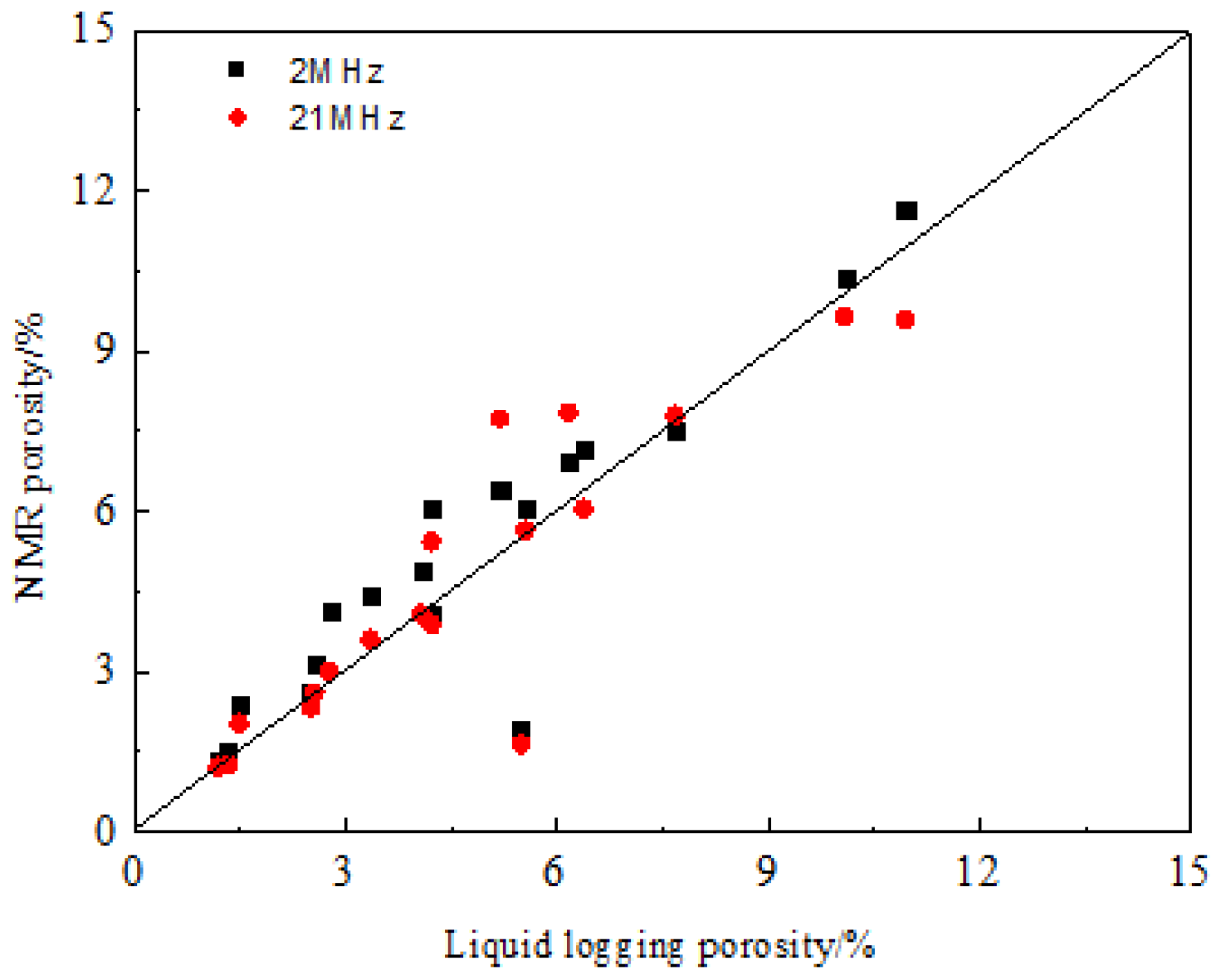
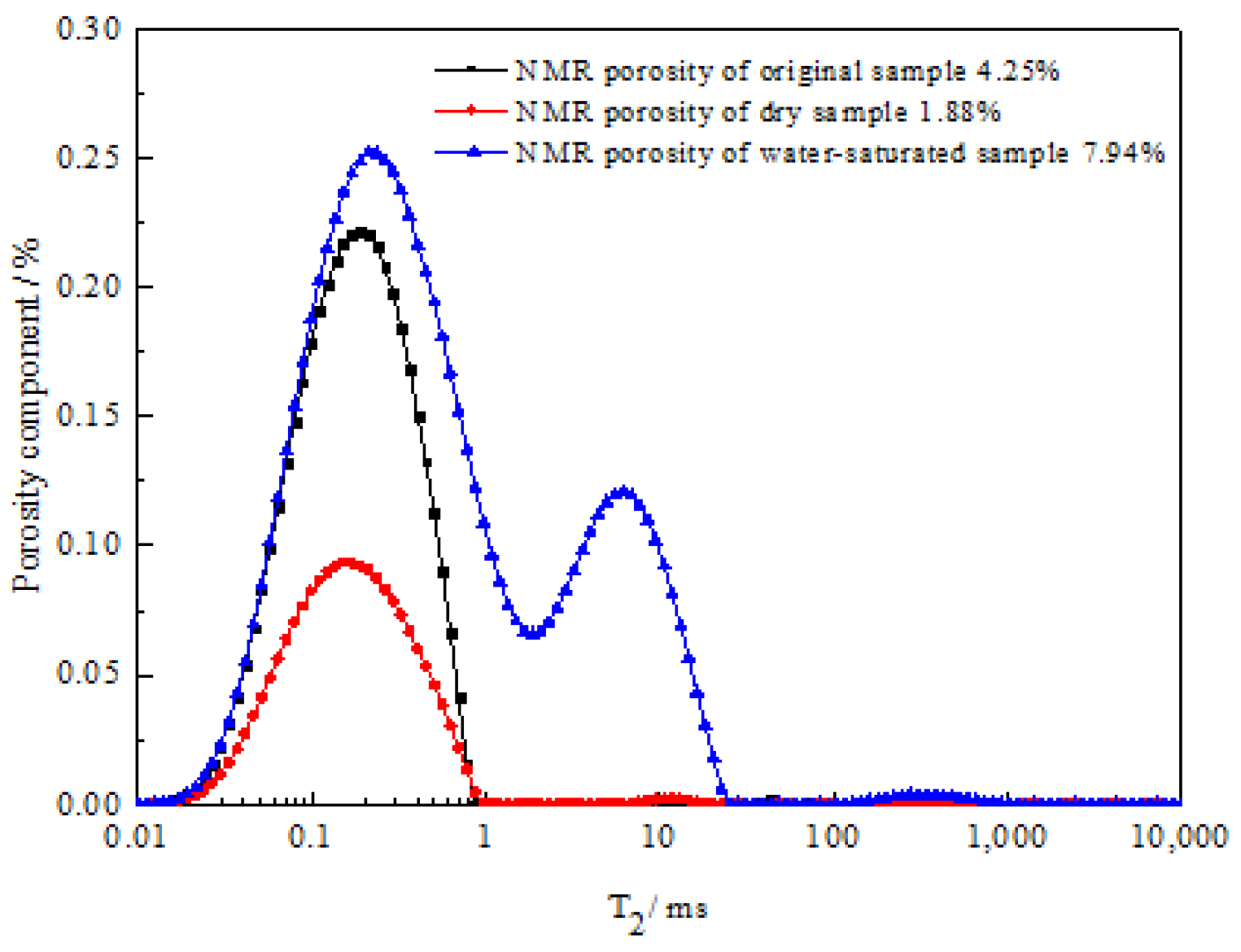
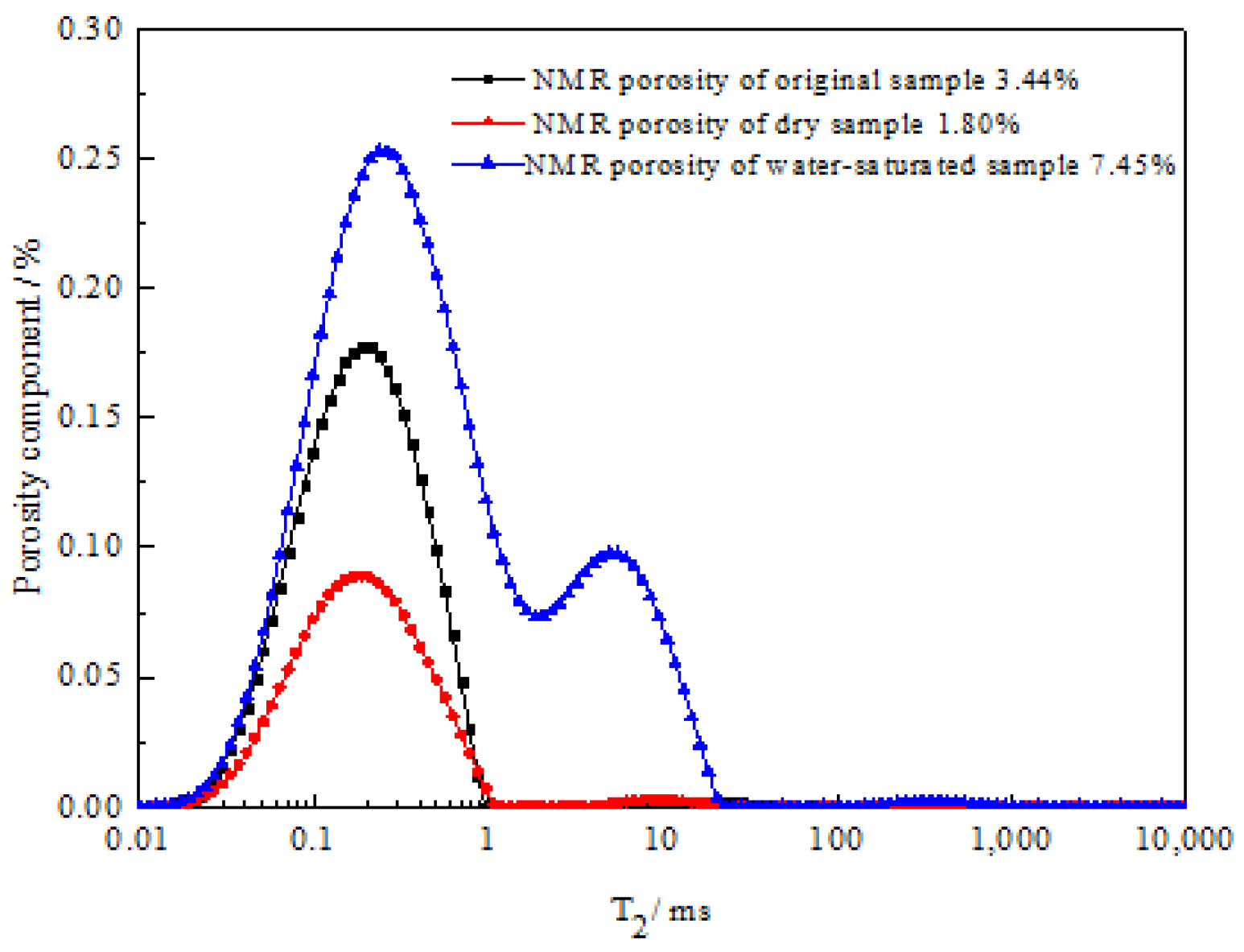

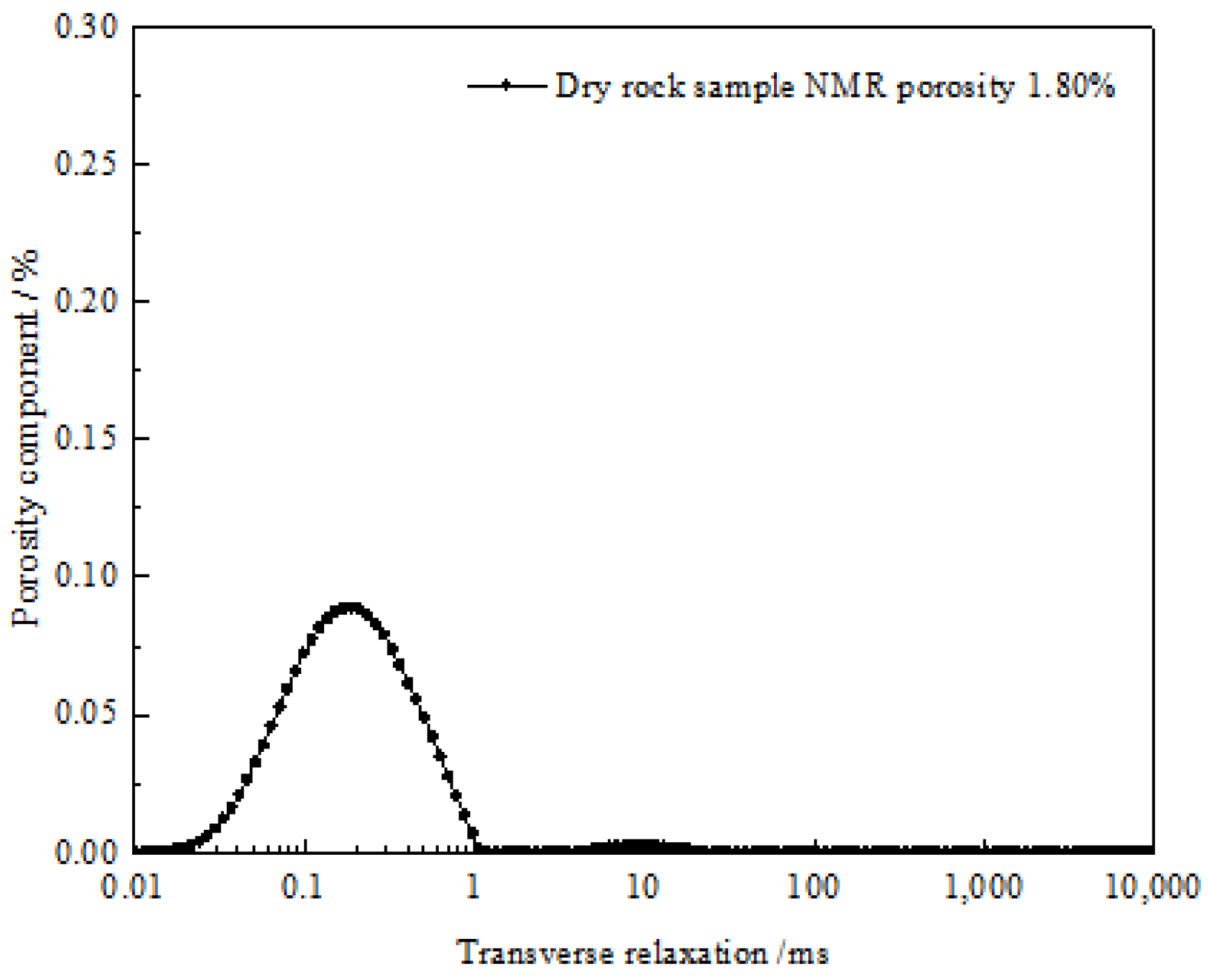
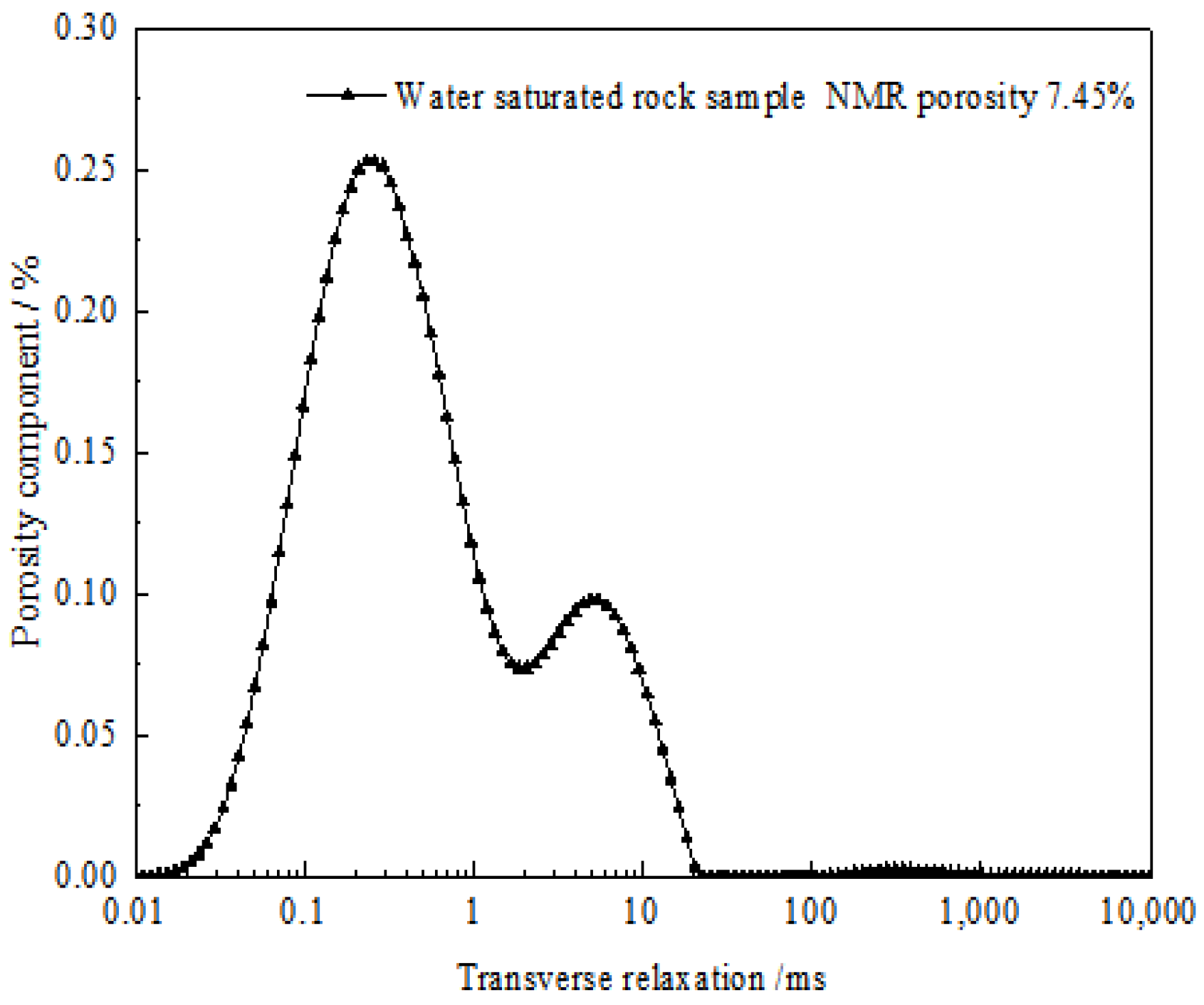
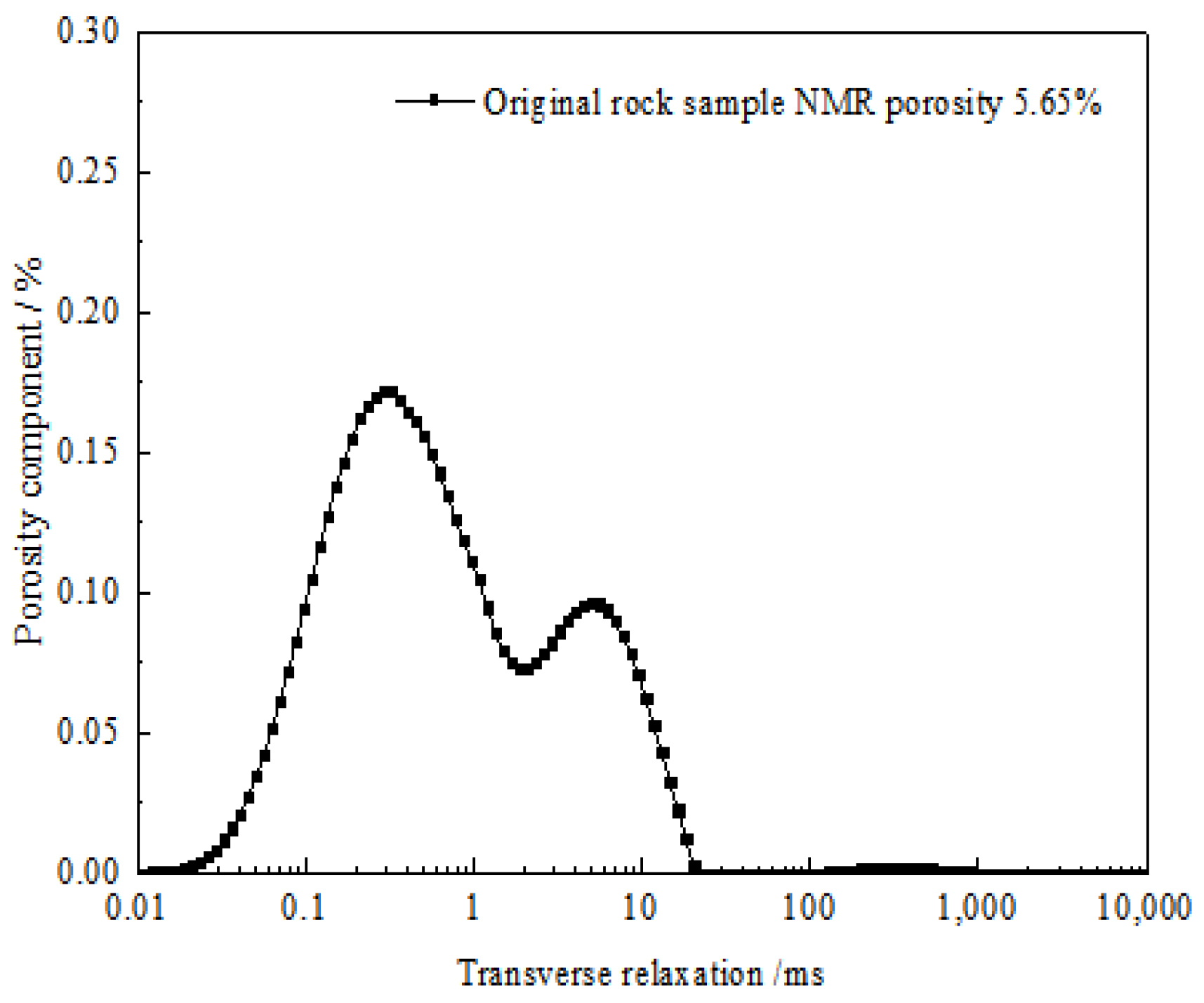


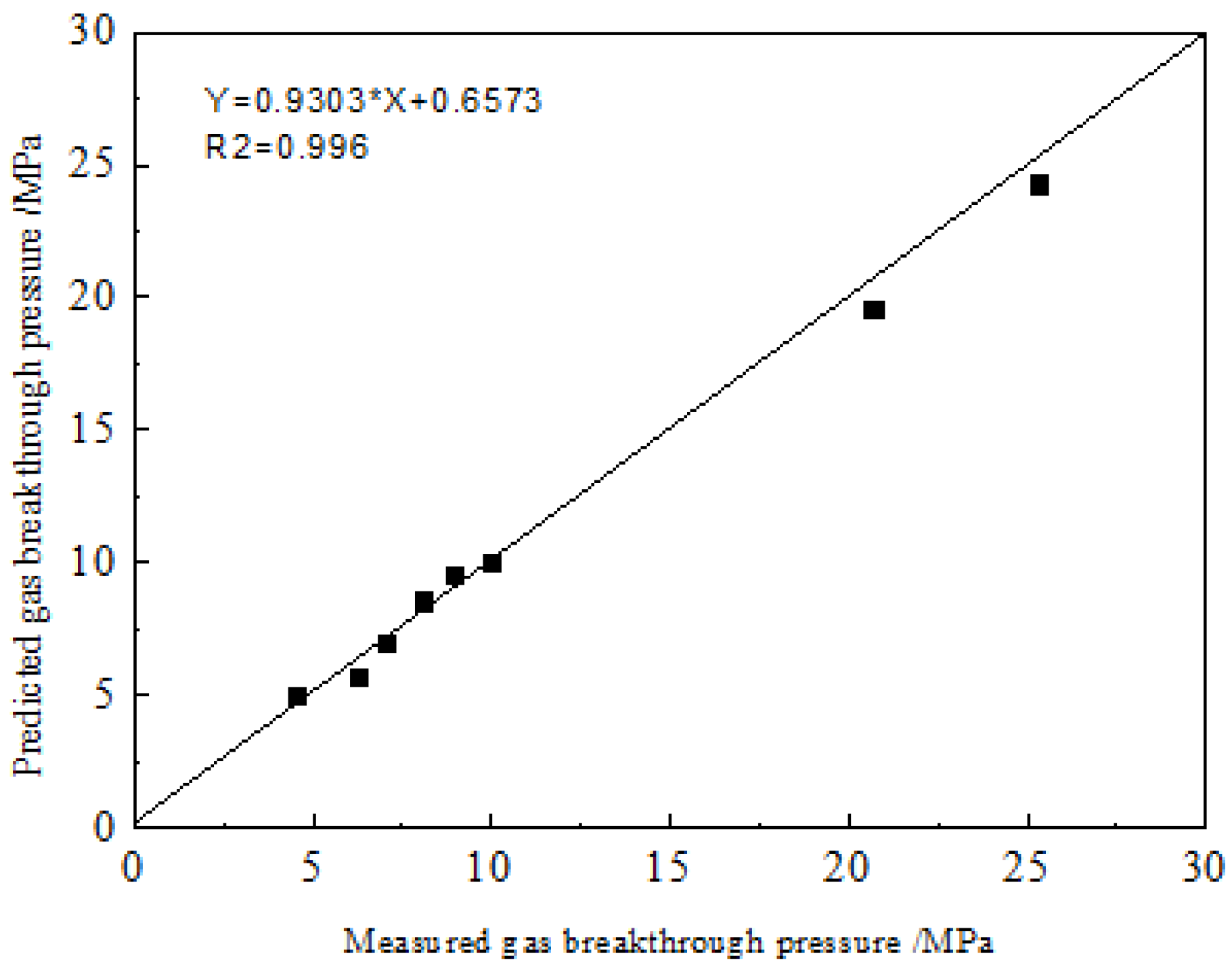
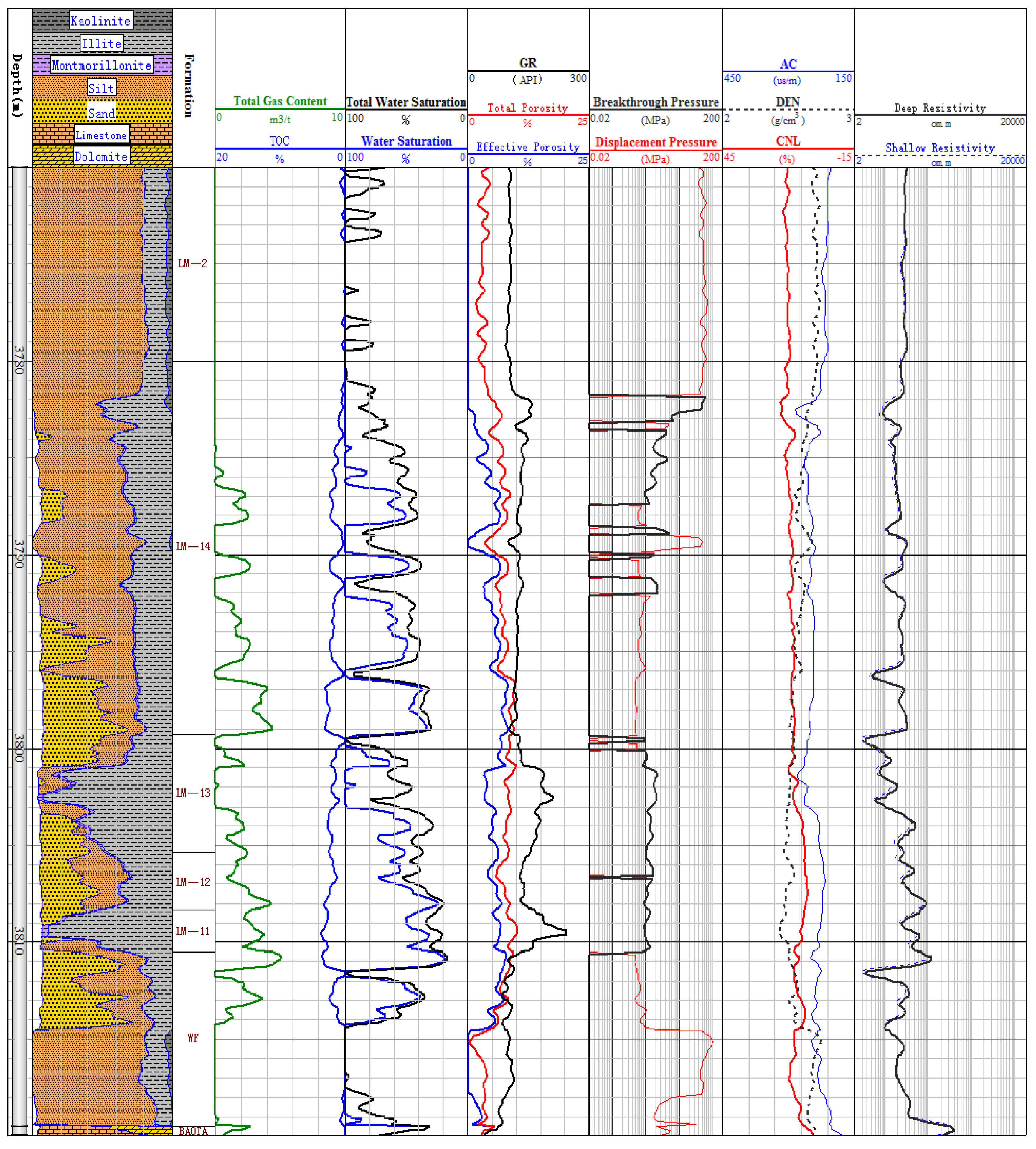
| No. | Crushing Porosity | Gas Logging Porosity | NMR Porosity of Dry Sample (2 MHz) | NMR Porosity of Dry Sample (21 MHz) | Liquid Logging Porosity | NMR Porosity of Water-Saturated Sample (21 MHz) | NMR Porosity of Water-Saturated Sample (2 MHz) | Permeability (mD) |
|---|---|---|---|---|---|---|---|---|
| 1 | 9.03 | 3.258 | 1.8806 | 1.8806 | 5.5784 | 7.4509 | 7.9445 | 0.011480799 |
| 2 | 7.81 | 3.0412 | 1.3158 | 1.3158 | 4.2465 | 6.6733 | 7.3744 | 0.015426499 |
| 3 | 1.76 | 1.425 | 0.6252 | 0.6252 | 1.3563 | 1.2738 | 2.1295 | 0.013562149 |
| 4 | 3.65 | 1.325 | 0.6134 | 0.4263 | 1.2120 | 1.221 | 1.962 | 0.599922067 |
| 5 | 4.59 | 1.689 | 1.304 | 1.0922 | 2.5889 | 3.6998 | 4.439 | 0.29579695 |
| 6 | 8.1 | 1.0571 | 0 | 1.0261 | 2.8662 | 4.029 | 4.1237 | 0.103749225 |
| 7 | 8.55 | 1.1265 | 1.3312 | 1.0949 | 4.2281 | 4.9797 | 5.4359 | 3.446945844 |
| 8 | 8.55 | 0.7126 | 0.7613 | 1.1921 | 3.4051 | 4.791 | 5.1885 | 0.033529845 |
| 9 | 7.42 | 4.4199 | 1.1127 | 1.3215 | 7.7299 | 7.8039 | 8.629 | 97.00213673 |
| 10 | 5.58 | 1.733 | 0.633 | 1.6496 | 6.4616 | 7.6988 | 7.787 | 14.66605484 |
| 11 | 14.4 | 4.8704 | 0.4653 | 1 | 11.0913 | 10.5897 | 12.0987 | 0.942860955 |
| 12 | 8.81 | 0.7189 | 0.6016 | 0.2631 | 1.8082 | 1.9086 | 2.526 | 0.153821733 |
| 13 | 8.81 | 1.4316 | 0.4484 | 0.3477 | 1.5231 | 2.3747 | 2.848 | 0.016848658 |
| 14 | 2.54 | 1.5984 | 0.8934 | 0.6756 | 2.5348 | 3.0062 | 3.517 | 0.015265075 |
Publisher’s Note: MDPI stays neutral with regard to jurisdictional claims in published maps and institutional affiliations. |
© 2022 by the authors. Licensee MDPI, Basel, Switzerland. This article is an open access article distributed under the terms and conditions of the Creative Commons Attribution (CC BY) license (https://creativecommons.org/licenses/by/4.0/).
Share and Cite
Xiao, J.; Xiao, Y.; Ge, X.; Zhou, T. A Technique to Determine the Breakthrough Pressure of Shale Gas Reservoir by Low-Field Nuclear Magnetic Resonance. Energies 2022, 15, 7223. https://doi.org/10.3390/en15197223
Xiao J, Xiao Y, Ge X, Zhou T. A Technique to Determine the Breakthrough Pressure of Shale Gas Reservoir by Low-Field Nuclear Magnetic Resonance. Energies. 2022; 15(19):7223. https://doi.org/10.3390/en15197223
Chicago/Turabian StyleXiao, Juanjuan, Yufeng Xiao, Xinmin Ge, and Tianqi Zhou. 2022. "A Technique to Determine the Breakthrough Pressure of Shale Gas Reservoir by Low-Field Nuclear Magnetic Resonance" Energies 15, no. 19: 7223. https://doi.org/10.3390/en15197223




